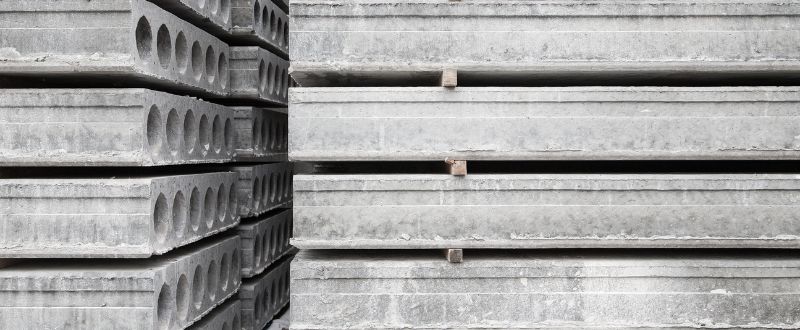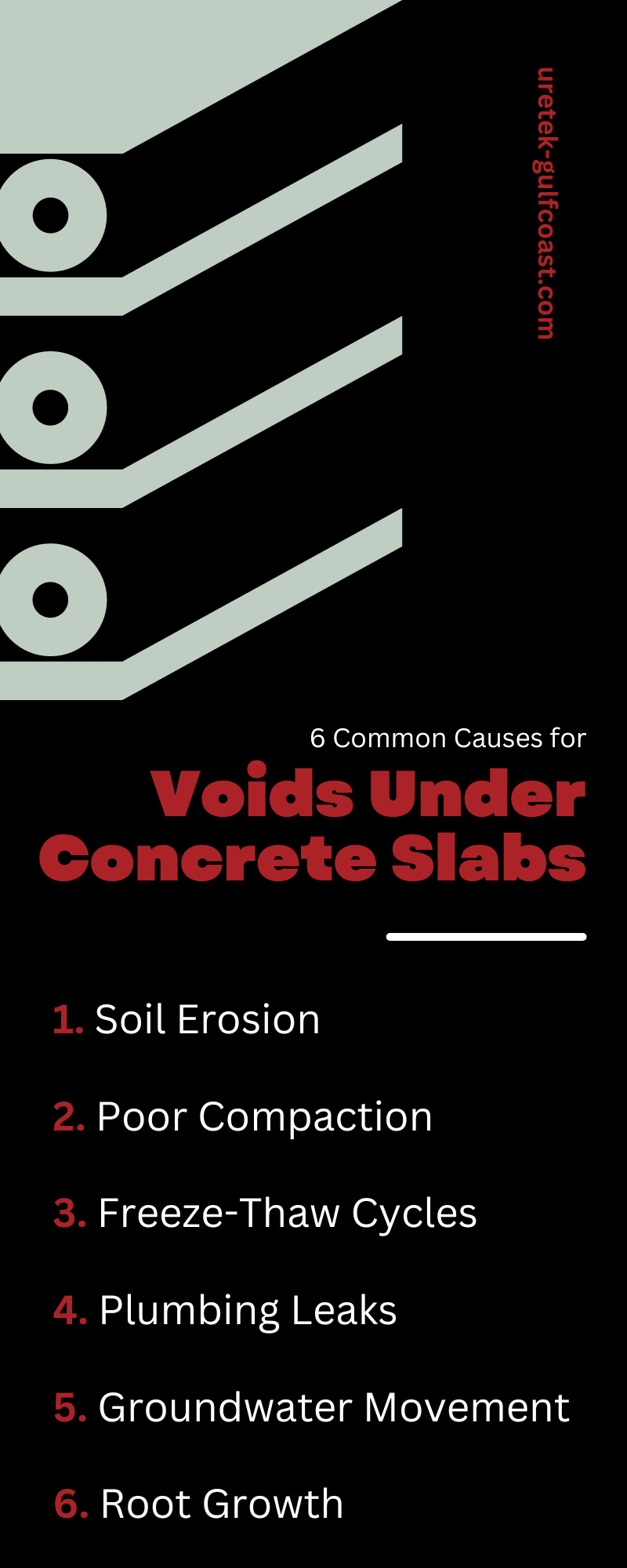One of the often-overlooked challenges of property management and home ownership lies beneath our feet: voids under concrete slabs. A soil void is an empty space or cavity beneath the ground that can significantly threaten the structural integrity of concrete slabs.
Voids can lead to cracking, sinking, or even complete failure of the concrete slab. Learn the six common causes for voids under concrete slabs to help prevent, identify, and address these costly and potentially dangerous issues.
1. Soil Erosion
Soil erosion occurs when water or wind dislodges particles from the soil, causing the soil to move or become displaced. As water seeps through the cracks or edges of the slab, it carries away the soil particles over time, ultimately leaving behind voids underneath. These voids can grow and merge, leading to catastrophic consequences. Changes in elevation, improper drainage systems, and fluctuating groundwater levels can all contribute to increased soil erosion risks under concrete slabs.
Polyurethane foam void filling is an effective tool for stopping and correcting soil erosion. The foam acts as a barrier to soil erosion by expanding and filling voids under concrete slabs, preventing water from flowing through and washing away the underlying soil. The foam’s expansion capabilities allow it to fill even small crevices, ensuring a comprehensive coverage that effectively stops soil movement. Additionally, the foam hardens after application, creating a strong and durable support structure that resists further erosion.
2. Poor Compaction
Another leading cause of voids beneath concrete slabs is poor compaction. When soil lacks adequate compression, it has a lower density and too many air spaces between soil particles. This lack of proper compaction can lead to structural instability, hinder plant growth due to excess air gaps, and create issues with water infiltration and soil erosion.
Insufficient soil compaction leaves the ground susceptible to further settling and movement under the slab. Contractors must ensure proper soil compaction during the initial stages of slab installation to prevent this issue.
3. Freeze-Thaw Cycles
Weather that causes water in the soil to freeze and thaw can negatively impact the ground beneath concrete slabs. As water in the soil freezes, it expands, pushing the soil particles apart. This process, known as frost heave, can cause the ground to rise or swell.
Once the temperatures rise again, the ice in the soil melts and leaves behind void spaces. These voids beneath the concrete slab may eventually lead to structural complications. It is crucial to consider proper insulation and drainage solutions during the installation process so that you can minimize the impact of freeze-thaw cycles on concrete slabs.
4. Plumbing Leaks
Plumbing leaks can significantly contribute to the formation of voids under concrete slabs. When a leak occurs, the water escaping from the pipe can erode the surrounding soil and create void spaces. These leaks can stem from burst pipes, broken sewer lines, broken joints, or small fissures in the plumbing system.
Plumbing leaks may allow larger and more severe voids to develop over time if not detected and addressed promptly. Regular inspection of your property’s plumbing system and swift repairs are essential for minimizing the potential for void damage to your concrete slabs.
5. Groundwater Movement
Damaged pipes aren’t the only source of water that creates subsurface voids. Groundwater is water located beneath the soil’s surface in the cracks and spaces in soil, sand, and rocks.
As groundwater travels through the various layers of soil, it can sometimes wash away finer particles, creating voids or cavities in the ground. These spaces allow more water to flow easily, resulting in even more erosion and an increased risk of slab settlement. A perfect example of this phenomenon is the formation of sinkholes, which can be particularly problematic in areas with limestone or other soluble rocks.
6. Root Growth
Tree roots can be surprisingly strong forces of nature. As they grow, they often seek water and nutrients in the soil and, in doing so, can push against or undermine the stability of nearby structures.
The growth of tree roots can cause soil to shift or become displaced, forming empty spaces beneath concrete slabs. Trees planted too close to driveways, sidewalks, or buildings might extend their roots underneath these structures, resulting in uneven or sinking concrete.
Sometimes, property owners can fill small voids with additional soil. However, you may require professional help for roots causing significant structural issues. A tree surgeon can carefully prune the offending roots without jeopardizing the tree’s health. In extreme cases, you may need to remove the tree to prevent further damage to the structure.
Prevention and Mitigation Tips
Preventing voids and mitigating their harm is crucial for maintaining safe residential and commercial structures. One preventative measure is regular inspection and maintenance, which can help you identify and address any signs of void formation early on. Homeowners and business owners should keep an eye out for signs such as sudden cracks in the structure, uneven floors, or doors that no longer close properly.
Aside from regular inspections, proper drainage is also key. Poorly directed water can lead to soil erosion, which might result in voids. Clean and maintain gutters and downspouts that direct water away from the building’s foundation.
A number of factors can cause soil voids, including soil erosion, poor soil compaction, freeze-thaw cycles, plumbing leaks, groundwater movement, and root growth. Ensure proper soil compaction, consider insulation and drainage solutions during slab installation, conduct regular inspections and maintenance, and manage tree root growth efficiently to prevent the formation of these voids. In addition, maintaining a functional drainage system that directs water away from the foundation of buildings can mitigate the adverse effects of soil erosion.
The timely identification and treatment of these voids can help maintain the structural integrity of the concrete slabs and prevent potential safety hazards. If you suspect empty spaces in the soil under your concrete slab, contact a professional to determine suitable treatment options.
A trained URETEK technician can conduct a thorough inspection and apply advanced solutions such as polyurethane foam injection to correct any voids, thereby ensuring the long-term stability and safety of your building. Call us today for fast, customer-friendly service.


